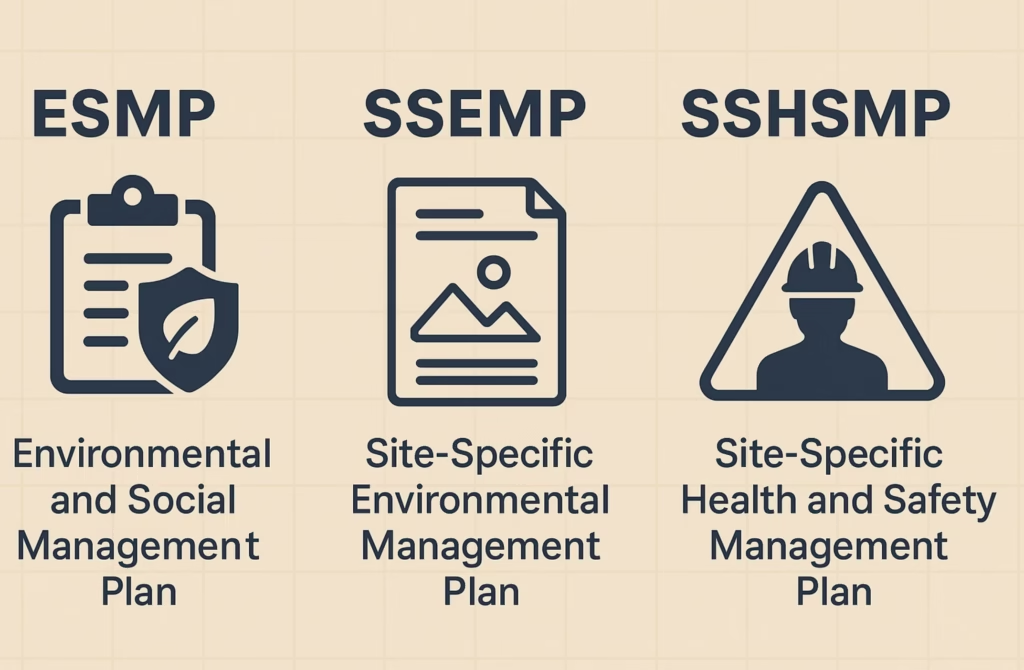When it comes to infrastructure development and large-scale projects, managing environmental and social impacts is not just good practice—it’s often a legal requirement. Among the most important tools used by developers, contractors, and environmental professionals are Environmental and Social Management Plans (ESMPs), Site-Specific Environmental Management Plans (SSEMPs), and Site-Specific Health and Safety Management Plans (SSHSMPs).
While these terms may sound similar and are sometimes mistakenly used interchangeably, they serve different but complementary purposes in ensuring responsible project execution.
1. ESMP – Environmental and Social Management Plan
📌 Definition:
The ESMP is a high-level document prepared as part of an Environmental and Social Impact Assessment (ESIA) or Initial Environmental Examination (IEE). It outlines the mitigation, monitoring, and institutional measures to be taken during the project lifecycle to minimize adverse environmental and social impacts.
🔍 Purpose:
To ensure that environmental and social risks are addressed systematically and comply with national regulations, lender requirements (e.g., ADB, World Bank), and international standards.
📄 Contents Typically Include:
- Description of potential environmental and social impacts
- Mitigation measures
- Monitoring plans
- Institutional responsibilities
- Capacity development and training needs
- Budget and timeline
- Grievance redress mechanisms
🏗️ Who Prepares It:
Usually prepared by the project proponent or a third-party environmental consultant at the planning or pre-construction stage.
2. SSEMP – Site-Specific Environmental Management Plan
📌 Definition:
The SSEMP is a more detailed, localized version of the ESMP, developed to address environmental risks at specific construction sites or work zones. It translates the broader mitigation strategies of the ESMP into actionable steps tailored to the unique conditions of a particular location.
🔍 Purpose:
To ensure that contractors and site engineers understand their specific environmental obligations during construction and take practical steps to avoid site-specific environmental impacts.
📄 Contents Typically Include:
- Site description and baseline conditions
- Specific mitigation measures (e.g., for noise, dust, water runoff)
- Site layout, access roads, and sensitive receptors
- Site-specific monitoring indicators
- Waste management and erosion control plans
- Emergency response procedures
🛠️ Who Prepares It:
Typically prepared by contractors or implementing agencies based on the ESMP, often reviewed and approved by the project management unit (PMU) or external monitors.
📍 Example:
In a road construction project, different SSEMPs would be prepared for different segments based on topography, proximity to water bodies, or local community presence.
3. SSHSMP – Site-Specific Health and Safety Management Plan
📌 Definition:
The SSHSMP focuses specifically on the occupational health and safety (OHS) of workers and the general public at a given site. While environmental management is part of SSEMP, the SSHSMP zeroes in on workplace safety protocols.
🔍 Purpose:
To prevent workplace accidents and health hazards by ensuring compliance with national labor laws, international safety standards (e.g., IFC, ILO), and project-specific requirements.
📄 Contents Typically Include:
- Site safety procedures and signage
- Risk assessments and hazard identification
- Personal protective equipment (PPE) policies
- Toolbox talks and safety training programs
- Emergency evacuation plans
- COVID-19 or other disease-specific protocols
- Incident reporting mechanisms
👷 Who Prepares It:
Prepared by contractors in consultation with site safety officers, and reviewed by project safety managers or health and safety auditors.
📍 Example:
A SSHSMP at a tunnel excavation site may include confined space entry protocols, ventilation monitoring, and rockfall protection measures.
📊 Summary Table: Key Differences
| Feature | ESMP | SSEMP | SSHSMP |
|---|---|---|---|
| Focus | Broad environmental and social impacts | Site-specific environmental issues | Site-specific health and safety |
| Prepared By | Project developers or consultants | Contractors or site teams | Contractors or safety officers |
| Stage | Planning/Design | Pre-construction/Construction | Construction/Operations |
| Scope | Project-wide | Site-specific | Site-specific |
| Reviewed By | Regulators, donors, lenders | PMUs, environmental monitors | Safety managers, auditors |
| Includes Social Aspects? | Yes | Sometimes | No (only safety-related) |
✅ Conclusion
Understanding the difference between ESMP, SSEMP, and SSHSMP is essential for effective environmental and social safeguards implementation. The ESMP sets the foundation, the SSEMP translates it into site-level actions, and the SSHSMP ensures that human health and workplace safety are not compromised.
In practice, these documents must work together to ensure project sustainability, regulatory compliance, and community trust.
If you’re involved in project development, make sure that all three plans are developed, implemented, and monitored with diligence and transparency.
Read More In Detail.





